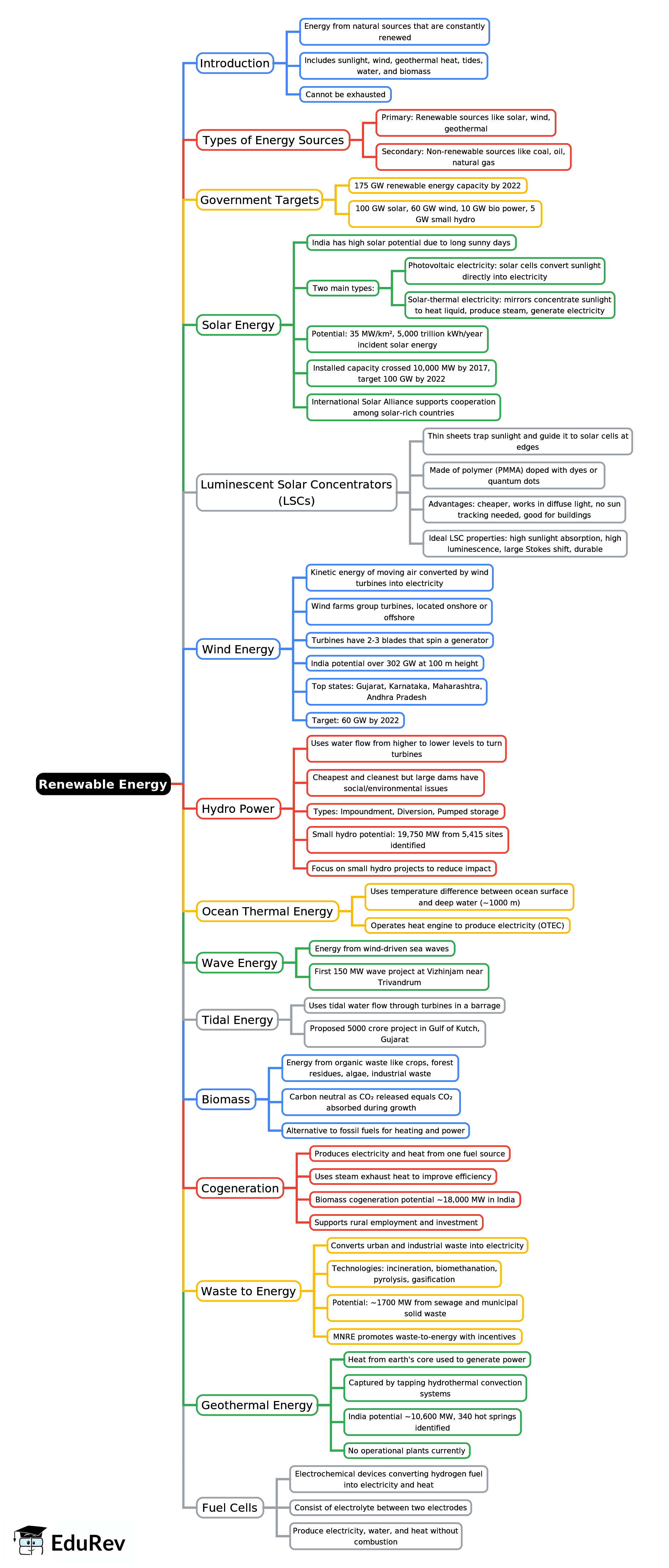UPSC Exam > UPSC Notes > Environment for UPSC CSE > Mind Map: Renewable Energy
Mind Map: Renewable Energy | Environment for UPSC CSE PDF Download

The document Mind Map: Renewable Energy | Environment for UPSC CSE is a part of the UPSC Course Environment for UPSC CSE.
All you need of UPSC at this link: UPSC
|
116 videos|304 docs|82 tests
|
FAQs on Mind Map: Renewable Energy - Environment for UPSC CSE
| 1. What are the main types of renewable energy sources? |  |
Ans. The main types of renewable energy sources include solar energy, wind energy, hydroelectric power, geothermal energy, and biomass. Solar energy harnesses sunlight using photovoltaic cells or solar thermal systems. Wind energy captures the kinetic energy from wind using turbines. Hydroelectric power generates electricity through the flow of water in rivers or dams. Geothermal energy utilizes heat from the Earth’s interior, while biomass involves using organic materials for energy production.
| 2. How does renewable energy contribute to environmental sustainability? |  |
Ans. Renewable energy contributes to environmental sustainability by reducing greenhouse gas emissions, decreasing reliance on fossil fuels, and minimizing pollution. Unlike conventional energy sources, renewables produce little to no carbon dioxide during operation. This transition helps mitigate climate change, conserves natural resources, and promotes cleaner air and water, thus supporting a healthier ecosystem.
| 3. What are the economic benefits of investing in renewable energy? |  |
Ans. Investing in renewable energy can lead to several economic benefits, including job creation, energy independence, and reduced energy costs. The renewable energy sector has been a significant source of employment, providing jobs in manufacturing, installation, and maintenance. Additionally, by relying more on domestic energy sources, countries can reduce their dependence on imported fuels, leading to greater energy security and price stability.
| 4. What challenges does the renewable energy sector face? |  |
Ans. The renewable energy sector faces challenges such as high initial investment costs, technological limitations, and intermittency issues. While operational costs are generally lower for renewable technologies, the upfront capital required for infrastructure can be substantial. Additionally, some renewable sources, like solar and wind, are dependent on weather conditions, which can lead to fluctuations in energy production that need to be managed effectively.
| 5. How do government policies influence the growth of renewable energy? |  |
Ans. Government policies play a crucial role in the growth of renewable energy through incentives, regulations, and subsidies. Supportive policies, such as tax credits, feed-in tariffs, and renewable portfolio standards, can encourage investment and development in the sector. Conversely, a lack of supportive legislation or the presence of subsidies for fossil fuels can hinder the progress of renewable energy adoption, affecting its competitiveness in the energy market.
Related Searches
















